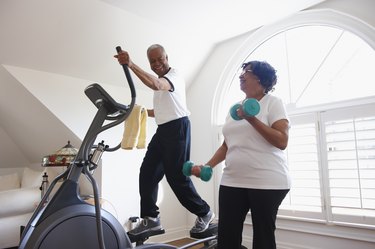

Fans of the elliptical love the cardio machine for its low-impact, steady-state workouts.
After all, regular cardio exercise is essential for good health. Everyone should aim to get 150 minutes of moderate-intensity cardio per week, according to the American Heart Association. And by being inherently low-impact, elliptical workouts are great for anyone who wants to take it easy on their joints.
Video of the Day
Video of the Day
But elliptical machine benefits don't stop there. The elliptical is a great weight-loss tool, especially if you incorporate high-intensity elliptical intervals and use healthy foods to fuel your workouts and support a moderate caloric deficit. (You create a caloric deficit when you burn more calories than you consume.)
Ready to start using the elliptical to lose weight? Here's how to get the best weight-loss benefits from your elliptical routine.
How to Lose Weight on the Elliptical
The Elliptical Burns Calories
The calories you burn during exercise contribute to your weight loss. Cue, the elliptical: In general, spending 30 minutes on the elliptical machine burns about 335 calories, according to Harvard Health Publishing. So, even just 30 minutes on the elliptical is enough to kickstart your weight loss.
But only 30 minutes probably won't be enough to lose weight — that's because you need to be in a calorie deficit to shed pounds. You need both exercise and nutrition (more on that below) to start losing weight.
The Elliptical Burns Fat
A steady-state 30-minute elliptical session may not shed too many calories. But when you pick up your pace and resistance levels with high-intensity interval training (HIIT), you can burn a lot more calories and body fat both during those 30 minutes and after your workout as your body recovers.
HIIT workouts involve alternating between periods of high-intensity work, followed by low-intensity recovery, according to the Mayo Clinic.
To use HIIT elliptical workouts to lose weight, try altering the pace or resistance of the elliptical machine to a hard-to-sustain level, depending on your current fitness level. You should feel too breathless to speak in full sentences during your high-intensity interval session, according to Harvard Health Publishing. Your recovery periods should feel comfortable and conversational.
Once you've settled on the pace and resistance needed for your high- and low-intensity periods, begin to alternate between the two.
What makes HIIT so good for burning fat across your whole body? (Yes, that includes belly fat.) Increasing the resistance in your workout builds muscle, which, in turn, increases the amount of calories your body burns at rest (aka your metabolic rate). In the long run, more muscle on your body can help improve your overall body composition (your ratio of lean muscle to body fat).
How Long Should You Be on the Elliptical to Lose Weight?
There's no hard-and-fast rule when it comes to time spent on the elliptical machine for weight loss. As mentioned above, you need to be in a calorie deficit in order to lose weight. For some people, 30 minutes may be plenty of time but for others, more may be needed. Your ideal elliptical time depends on your body and eating habits.
Using Nutrition to Maximize Your Elliptical Machine Weight Loss
While your elliptical workouts can definitely help you reach your weight-loss goal, it'll be a lot harder to lose 20 pounds (or whatever your target number is) without also maintaining a healthy diet.
To lose weight, you need to create a sustainable caloric deficit using both diet and exercise. Finding the best caloric deficit for your body takes a little trial and error, but you can begin by finding how many calories you need to eat to maintain your current weight. To determine it, track your typical caloric intake for several days.
From there, if you maintain a sustainable 500- to to 1,000-calorie deficit (including both exercise and diet), you can expect to drop around 1 to 2 pounds per week, according to the Mayo Clinic.
Remember, the goal is to create a sustainable plan, so if cutting 500 calories leaves you feeling hungry, only cut 200. It's important to consider what's best for your body.
Elliptical Workouts for Weight Loss
As mentioned above, there are plenty of elliptical workouts you can try to help promote weight loss and increase your calorie burn. A good starting point? Getting a minimum of 150 minutes of moderate intensity exercise or 75 minutes of vigorous intensity aerobic physical activity each week, according to the Centers for Disease Control and Prevention. That comes out to between 15 and 30 minutes of cardio five days a week.
When you feel ready for more challenge, try one of these elliptical workouts below.
Elliptical Workouts to Try
Other Elliptical Benefits
It's Low Impact
Unlike the treadmill, ellipticals are low impact and less strenuous on your joints, according to Harvard Health Publishing. When you run or jump, your knees and hips absorb a lot of shock, which can be painful over time. On the contrary, low-impact exercise offers a good workout without extra wear and tear.
It Promotes Heart Health
Whether you'e doing a steady-state or interval elliptical session, training on the elliptical provides plenty of benefits for your cardiovascular system. Regular cardio exercise can help lower your blood pressure and raise your HDL (good) cholesterol levels, according to the National Heart, Lung, and Blood Institute.
It Works Your Muscles
Also unlike the treadmill, the elliptical offers some muscle-building benefits, according to Harvard Health Publishing. By adding resistance to your machine, you can target your lower-body muscles and your upper-body, thanks to the handles.
More Need-to-Know Elliptical Info
- American Heart Association: "American Heart Association Recommendations for Physical Activity in Adults and Kids"
- Harvard Health Publishing: "Calories burned in 30 minutes for people of three different weights"
- Mayo Clinic: "Infographic: High Intensity Interval Training (HIIT)"
- Harvard Health Publishing: "Want better exercise results in less time? Try interval training to boost your workout"
- Mayo Clinic: "Counting calories: Get back to weight-loss basics"
- National Heart, Lung, and Blood Institute: "PHYSICAL ACTIVITY AND YOUR HEART Benefits"
- Harvard Health Publishing: "Choosing a Home Exercise Machine"
- CDC: "How Much Physical Activity Do Adults Need?"
- American Council on Exercise: Exercise Library



